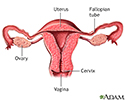Vaginal cysts
Inclusion cyst; Gartner duct cyst
A cyst is a closed pocket or pouch of tissue. It can be filled with air, fluid, pus, or other material. A vaginal cyst occurs on or under the vaginal lining.
Causes
There are several types of vaginal cysts.
- Vaginal inclusion cysts are the most common. These may form as a result of injury to the vaginal walls during birth process or after surgery.
- Gartner duct cysts develop on the side walls of the vagina. This duct is present while a baby is developing in the womb but will most often disappear after birth. If parts of the duct remain, they may collect fluid and develop into a vaginal wall cyst later in life.
-
Bartholin cyst or abscess
is the buildup of fluid for pus that forms a lump in one of the glands found on each side of the vaginal opening.
Bartholin cyst or abscess
Bartholin abscess is the buildup of pus that forms a lump (swelling) in one of the Bartholin glands. These glands are found on each side of the vagi...
 ImageRead Article Now Book Mark Article
ImageRead Article Now Book Mark Article - Pieces of endometriosis may appear as small cysts in the vagina.
- Benign tumors of the vagina are uncommon. They are most often composed of cysts.
- Cystoceles and rectoceles are bulges in the vaginal wall from the underlying bladder or rectum. These are not really cysts, but can look and feel like cystic masses in the vagina.
Symptoms
Most vaginal cysts usually do not cause symptoms. In some cases, a soft lump can be felt in the vaginal wall or protruding from the vagina. Cysts range in size from the size of a pea to that of an orange.
However, Bartholin cysts can commonly become infected, swollen and painful.
Some women with vaginal cysts may have discomfort during sex or trouble inserting a tampon.
Women with cystoceles or rectoceles may feel a protruding bulge, pelvic pressure or have difficulty with urination or defecation.
Exams and Tests
Physical exam is essential to determine what type of cyst or mass you may have.
A mass or bulge of the vaginal wall may be seen during a pelvic exam. You may need a biopsy to rule out vaginal cancer, especially if the mass appears to be solid.
If the cyst is located under the bladder or urethra, x-rays may be needed to see if the cyst extends into these organs.
Treatment
Routine exams to check the size of the cyst and look for any changes may be the only treatment needed.
Biopsies or minor surgeries to remove the cysts or drain them are typically simple to perform and resolve the issue.
Bartholin gland cysts often need to be drained. Sometimes, antibiotics are prescribed to treat them as well.
Outlook (Prognosis)
Most of the time, the outcome is good. Cysts often remain small and do not need treatment. When surgically removed, the cysts usually do not return.
Bartholin cysts can sometimes recur and need ongoing treatment.
Possible Complications
In most cases, there are no complications from the cysts themselves. A surgical removal carries a small risk of complication. The risk depends on where the cyst is located.
When to Contact a Medical Professional
Call your health care provider if a lump is felt inside the vagina or is protruding from the vagina. It is important to contact your provider for an exam for any cyst or mass you notice.
References
Baggish MS. Benign lesions of the vaginal wall. In: Baggish MS, Karram MM, eds. Atlas of Pelvic Anatomy and Gynecologic Surgery . 4th ed. Philadelphia, PA: Elsevier; 2016:chap 61.
Katz VL. Benign gynecologic lesions. In: Lentz GM, Lobo RA, Gershenson DM, Katz VL, eds. Comprehensive Gynecology . 6th ed. Philadelphia, PA: Elsevier Mosby; 2012:chap 18.
-
Female reproductive anatomy - illustration
External structures of the female reproductive anatomy include the labium minora and majora, the vagina and the clitoris. Internal structures include the uterus, ovaries and cervix.
Female reproductive anatomy
illustration
-
Uterus - illustration
The uterus is a hollow muscular organ located in the female pelvis between the bladder and rectum. The ovaries produce the eggs that travel through the fallopian tubes. Once the egg has left the ovary it can be fertilized and implant itself in the lining of the uterus. The main function of the uterus is to nourish the developing fetus prior to birth.
Uterus
illustration
-
Normal uterine anatomy (cut section) - illustration
The uterus is a muscular organ with thick walls, two upper openings to the fallopian tubes and an inferior opening to the vagina.
Normal uterine anatomy (cut section)
illustration
-
Female reproductive anatomy - illustration
External structures of the female reproductive anatomy include the labium minora and majora, the vagina and the clitoris. Internal structures include the uterus, ovaries and cervix.
Female reproductive anatomy
illustration
-
Uterus - illustration
The uterus is a hollow muscular organ located in the female pelvis between the bladder and rectum. The ovaries produce the eggs that travel through the fallopian tubes. Once the egg has left the ovary it can be fertilized and implant itself in the lining of the uterus. The main function of the uterus is to nourish the developing fetus prior to birth.
Uterus
illustration
-
Normal uterine anatomy (cut section) - illustration
The uterus is a muscular organ with thick walls, two upper openings to the fallopian tubes and an inferior opening to the vagina.
Normal uterine anatomy (cut section)
illustration
Review Date: 11/5/2015
Reviewed By: Cynthia D. White, MD, Fellow American College of Obstetricians and Gynecologists, Group Health Cooperative, Bellevue, WA. Also reviewed by David Zieve, MD, MHA, Isla Ogilvie, PhD, and the A.D.A.M. Editorial team.



